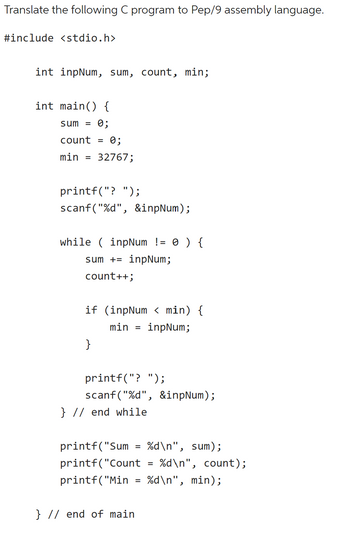
Computer Networking: A Top-Down Approach (7th Edition)
7th Edition
ISBN: 9780133594140
Author: James Kurose, Keith Ross
Publisher: PEARSON
expand_more
expand_more
format_list_bulleted
Question

Transcribed Image Text:Translate the following C program to Pep/9 assembly language.
#include <stdio.h>
int inpNum, sum, count, min;
int main() {
sum = 0;
count =
0;
min = 32767;
printf("? ");
scanf("%d", &inpNum);
while (inpNum != 0 ) {
sum += inpNum;
count++;
if (inpNum < min) {
min = inpNum;
}
printf("? ");
scanf("%d", &inpNum);
} // end while
printf("Sum
printf("Count
printf("Min
} // end of main
=
=
%d\n", sum);
=
%d\n", count);
%d\n", min);
Expert Solution
This question has been solved!
Explore an expertly crafted, step-by-step solution for a thorough understanding of key concepts.
This is a popular solution
Trending nowThis is a popular solution!
Step by stepSolved in 2 steps

Knowledge Booster
Similar questions
- How does the concept of 'garbage collection' contribute to memory management in programming languages?arrow_forwardConvert the following c++ code into pep9 assembly language. #include <iostream> using namespace std; void times(int& prod, int mpr, int mcand) { prod = 0; while (mpr != 0) { if (mpr % 2 == 1) prod = prod + mcand; mpr /= 2; mcand *= 2; } } int main(){ int product, n, m; cout << "Enter two numbers: "; cin >> n >> m; times(product, n, m); cout << "Product: " << product << endl; return 0; }arrow_forwardConvert the following c++ code into pep9 assembly language #include <iostream> using namespace std; void times(int& prod, int mpr, int mcand) { prod = 0; while (mpr != 0) { if (mpr % 2 == 1) prod = prod + mcand; mpr /= 2; mcand *= 2; } } int main(){ int product, n, m; cout << "Enter two numbers: "; cin >> n >> m; times(product, n, m); cout << "Product: " << product << endl; return 0; }arrow_forward
- Convert the following into Pep/9 Assembler: #include using namespace std; int square(int n){ int i; int sq; sq = 0; for (i = 0; i < n; i++){ sq = sq + n; } return sq; } int main (){ int num; cout << "Enter a number: "; cin >> num; cout << num << " squared = " << square(num) << endl; return 0; }arrow_forwardConvert the following into Pep/9 Assembler: #include <iostream>using namespace std;int square(int n){ int i; int sq; sq = 0; for (i = 0; i < n; i++){ sq = sq + n; } return sq;}int main (){ int num; cout << "Enter a number: "; cin >> num; cout << num << " squared = " << square(num) << endl; return 0;} Submit: Source file along with screen captures showing the program running in the Pep simulator.arrow_forwardComplete the following C++ programs into Pep/9 assembly language: 1) int main(){int cop; int driver; cop = 0; driver = 40; while (cop <= driver) { cop += 25; driver += 20; } cout << cop; return 0;}arrow_forward
- Example: The Problem Input File Using C programming language write a program that simulates a variant of the Tiny Machine Architecture. In this implementation memory (RAM) is split into Instruction Memory (IM) and Data Memory (DM). Your code must implement the basic instruction set architecture (ISA) of the Tiny Machine Architecture: //IN 5 //OUT 7 //STORE O //IN 5 //OUT 7 //STORE 1 //LOAD O //SUB 1 55 67 30 55 67 1 LOAD 2- ADD 3> STORE 4> SUB 5> IN 6> OUT 7> END 8> JMP 9> SKIPZ 31 10 41 30 //STORE O 67 //OUT 7 11 /LOAD 1 //OUT 7 //END 67 70 Output Specifications Each piece of the architecture must be accurately represented in your code (Instruction Register, Program Counter, Memory Address Registers, Instruction Memory, Data Memory, Memory Data Registers, and Accumulator). Data Memory will be represented by an integer array. Your Program Counter will begin pointing to the first instruction of the program. Your simulator should provide output according to the input file. Along with…arrow_forwardtranslate a c++ program into pep/9 assembly language #include <iostream> using namespace std; int myAge;void ShowVal(int age){ cout << "Age:" << age << endl;} int main() {cout << "Enter age: ";cin >> myAge;ShowVal(myAge);return 0;}arrow_forward15. Translate the following C program to Pep/9 assembly language. #include int main() { int numitms, j, data, sum; scanf("%d", &numItms); sum = 0; for (j = 1; j <= numitms; j++) { scanf("%d", &data); sum += data; } printf ("Sum: %d\n", sum); return 0; } Sample Input 48-376 Sample Output Sum: 18arrow_forward
arrow_back_ios
arrow_forward_ios
Recommended textbooks for you
 Computer Networking: A Top-Down Approach (7th Edi...Computer EngineeringISBN:9780133594140Author:James Kurose, Keith RossPublisher:PEARSON
Computer Networking: A Top-Down Approach (7th Edi...Computer EngineeringISBN:9780133594140Author:James Kurose, Keith RossPublisher:PEARSON Computer Organization and Design MIPS Edition, Fi...Computer EngineeringISBN:9780124077263Author:David A. Patterson, John L. HennessyPublisher:Elsevier Science
Computer Organization and Design MIPS Edition, Fi...Computer EngineeringISBN:9780124077263Author:David A. Patterson, John L. HennessyPublisher:Elsevier Science Network+ Guide to Networks (MindTap Course List)Computer EngineeringISBN:9781337569330Author:Jill West, Tamara Dean, Jean AndrewsPublisher:Cengage Learning
Network+ Guide to Networks (MindTap Course List)Computer EngineeringISBN:9781337569330Author:Jill West, Tamara Dean, Jean AndrewsPublisher:Cengage Learning Concepts of Database ManagementComputer EngineeringISBN:9781337093422Author:Joy L. Starks, Philip J. Pratt, Mary Z. LastPublisher:Cengage Learning
Concepts of Database ManagementComputer EngineeringISBN:9781337093422Author:Joy L. Starks, Philip J. Pratt, Mary Z. LastPublisher:Cengage Learning Prelude to ProgrammingComputer EngineeringISBN:9780133750423Author:VENIT, StewartPublisher:Pearson Education
Prelude to ProgrammingComputer EngineeringISBN:9780133750423Author:VENIT, StewartPublisher:Pearson Education Sc Business Data Communications and Networking, T...Computer EngineeringISBN:9781119368830Author:FITZGERALDPublisher:WILEY
Sc Business Data Communications and Networking, T...Computer EngineeringISBN:9781119368830Author:FITZGERALDPublisher:WILEY

Computer Networking: A Top-Down Approach (7th Edi...
Computer Engineering
ISBN:9780133594140
Author:James Kurose, Keith Ross
Publisher:PEARSON

Computer Organization and Design MIPS Edition, Fi...
Computer Engineering
ISBN:9780124077263
Author:David A. Patterson, John L. Hennessy
Publisher:Elsevier Science

Network+ Guide to Networks (MindTap Course List)
Computer Engineering
ISBN:9781337569330
Author:Jill West, Tamara Dean, Jean Andrews
Publisher:Cengage Learning

Concepts of Database Management
Computer Engineering
ISBN:9781337093422
Author:Joy L. Starks, Philip J. Pratt, Mary Z. Last
Publisher:Cengage Learning

Prelude to Programming
Computer Engineering
ISBN:9780133750423
Author:VENIT, Stewart
Publisher:Pearson Education

Sc Business Data Communications and Networking, T...
Computer Engineering
ISBN:9781119368830
Author:FITZGERALD
Publisher:WILEY